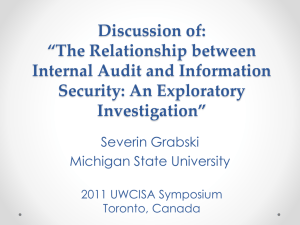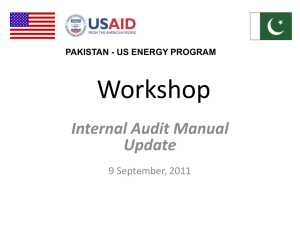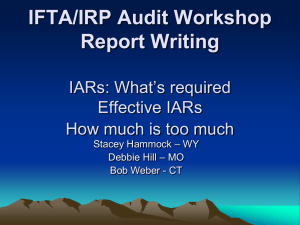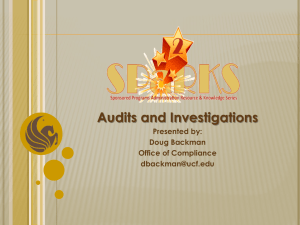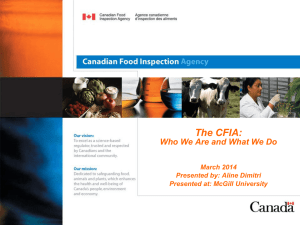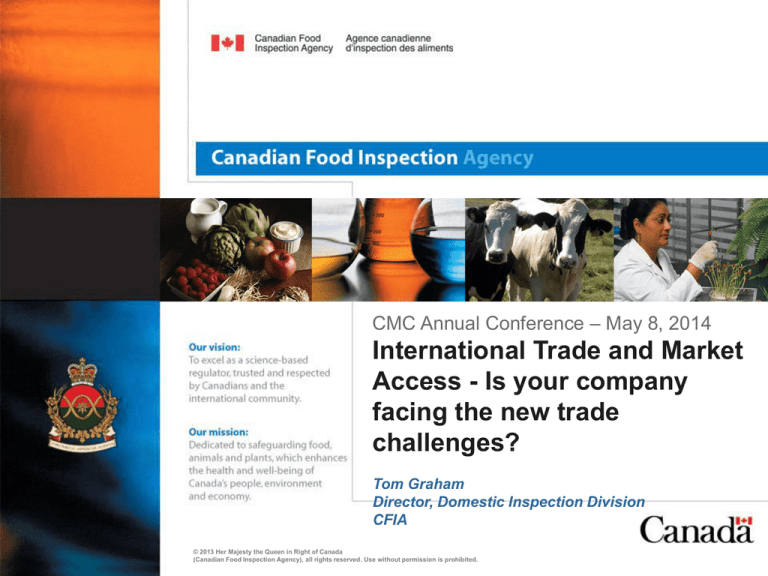
CMC Annual Conference – May 8, 2014
International Trade and Market
Access - Is your company
facing the new trade
challenges?
Tom Graham
Director, Domestic Inspection Division
CFIA
© 2013 Her Majesty the Queen in Right of Canada
(Canadian Food Inspection Agency), all rights reserved. Use without permission is prohibited.
Market Access
• Definition: Re-opening, maintaining and
expanding markets to the Canadian
industry.
• With almost half of Canada's total
agricultural and food production
exported, the potential for
growth in these sectors
lies in its ability to expand
markets abroad, making
market access a key
priority for both industry and
governments.
2
Increase Market Access: Gov’t & Industry’s Role
Industry
Foreign
Affairs, Trade
and
Development
Canada
Agriculture
and AgriFood
Canada
Canadian
Food
Inspection
Agency
3
Identifying Priorities
Every year, the Government (helped by Industry)
identifies “priority markets” deemed to hold the most
potential for Canadian exports of agri-food. For
example:
1. Established markets: European Union (EU),
Japan, Mexico, South Korea, Taiwan, United States
(US), etc.
2. Emerging markets: China, India, Indonesia,
Russia, etc.
4
Outcome of this Ambitious Trade
Agenda
• As a result of the intense promotion and negotiation
work done abroad, importing countries send foreign
delegations to verify, audit, inspect and/or gather
information on Canada’s food inspection system
and/or on regulated parties.
• The number of requests to host incoming foreign
missions has increased in recent years, and is
anticipated to increase even more in the future.
• In 2011–2012, the CFIA received 45 audit and
inspection missions from more than 21 foreign entities.
In 2012–2013, 48 missions were scheduled.
5
Purpose of Foreign Missions
Examples:
1. visits for new, expanded or to regain market access
2. audits and/or inspections for ongoing market access
3. technical assistance, cooperation, outreach, and
capacity building
4. bilateral sanitary and phytosanitary (SPS)
committees
5. consultative committees on agriculture (CCAs)
6. other senior-level meetings, working group meetings,
and invitations and relationship-building.
6
Foreign Audits
Audit – Audits of the Canadian inspection systems are
conducted to maintain or expand Canadian access to an
existing market, or to obtain access to a new market.
Audits encompass both the:
•
evaluation of a country’s regulatory system (i.e. CFIA’s
Meat Inspection System) and;
•
the inspection of Establishments as part of the
examination process.
Foreign
Audits
CFIA
Inspection
System
CFIA Field
Staff
Fed.
Reg’d
Est
7
Incoming Foreign Audits
Process
8
Foreign Audits Process - Preparation
1. Government of Canada receives foreign audit
requests.
2. Sometimes we are notified as short as 2 weeks prior
to the actual audit date.
3. It is at this time that we are informed of
Establishments selection. It can be:
1.
2.
3.
Chosen by the Foreign Country;
Chosen by CFIA;
On a voluntary basis.
4. If Establishments are chosen by the Foreign Country
it is often based on: violations at Point-of-Entry,
volume exported, recall history, etc.
5. Audit Itinerary is then drafted by both the Foreign
Country and CFIA.
9
Foreign Audits Process - Preparation
5. The foreign country may share with CFIA a “foreign
country requirements’ verification checklist” and/or a
“questionnaire” to be filled out by Establishments
and/or CFIA prior to the audit. Often this
questionnaire needs to be translated from foreign
country language into both French and English.
6. Once these documents are translated they are
forwarded to local CFIA staff for distribution to
Establishments.
7. Local CFIA staff, accompanied by Area and/or
National CFIA staff are then required to conduct a
“Pre-Audit Verification Activity” in each
Establishment to verify compliance to Canadian and
foreign country requirements (as published in MOP).
10
Foreign Audits Process - Preparation
8. Preparation by Industry: If your Establishment is
selected for a foreign audit, as best practices the
following activities can be done ahead of time to help
prepare:
a) Ensure your HACCP System is complete and up-to-date;
b) Prepare ahead of time an itinerary for the plant tour;
c) Do several walks-around and ensure interior and exterior’s condition
are in optimal condition (no loose caulking, no dirt or build-up on
overheads, equipment in good condition, etc). If necessary reprioritize already issued work-orders to be completed prior to the
audit;
d) Re-prioritize non-daily cleaning schedule so these items are cleaned
prior to the audit;
e) Conduct an employee meeting and provide a refresher GMP training;
f) During the audit, ensure you have reliable employees conducting
operational sanitation tasks, removing condensation, etc..
11
Foreign Audits Process – Opening
Meeting
9. Once the Foreign Delegation arrive in Canada the
CFIA will host an opening meeting in Ottawa.
10. During this meeting CFIA provide to the delegation
information on the Canadian Inspection System so
they have a full understanding of our system before
they start auditing Establishments.
12
Foreign Audits Process - Delivery
11. During the foreign audits, the following Government
of Canada’s staff may accompany the auditors:
• National Operations and/or National Program staff
• Area Export Specialist
• Regional Veterinary Officer
• Supervisor
• Veterinarian or Inspector In Charge of your Establishment
• Translators
• AAFC’s Market Access Secretariat Officer
12. The Foreign Delegation may be composed of one to
several Auditors, however there is always a Lead
Auditor.
13
Foreign Audits Process - Delivery
13. During plant tours, the Establishment’s highest
official (Quality Assurance or Production) should
accompanying the Foreign Lead Auditor during the
tour.
14. During the tour, this company representative should
follow the Foreign Lead Auditor side-by-side and
take good notes of his or her observations.
15. If the Foreign Lead Auditor seems to focus his or her
“gaze” on a particular area of the room that is a food
safety issue or could potentially be a food safety
issue, the company representative should
immediately “take charge” and control of the
situation and immediately correct the issue. Ideally
even before the Foreign Lead Auditor say anything.
14
Foreign Audits Process - Delivery
16. Each Foreign Auditor has different audit style. For
example, some will remain silent and point with their
flashlight and if no-one is there to see those findings,
these findings will remain undocumented until found
in the foreign country final report.
17. Always show respect to the Auditor’s work, do not
have a confrontational attitude. This will not help
your Establishment and the industry as a whole.
18. Remember the true purpose of these audits is to
either:
a) Open new markets to Canadian products, expand existing market to
more products or maintain actual market to Canadian products.
b) Convince that your Establishment meets all necessary requirements
and should be allowed to be on the list of Establishments eligible to
export to this Country.
15
Foreign Audits Process – Audit
Findings
19. Good audit practices requires Foreign Auditors to
discuss audit findings at the Establishment’s closing
meeting but they do not always do.
20. All audit findings will be documented by the CFIA
inspector on CVS Task “3.3.01 – Foreign Audit”. This
task has just been revised and will be published
shortly:
On this new task, all Audit Findings made by
Foreign Auditors will be “sorted” into 4 categories
of findings.
16
Audit Findings – Canadian Requirements
Items noted by the
foreign auditor
CFIA method of documentation
Audit finding
related to
Canadian
domestic
requirements
(MOP & FSEP).
1- According to Chapter
18, a CAR must be issued
when there are deviations
to the regulatory
requirements or HACCP
system which:
• could cause or have caused product
contamination or adulteration;
• affect the integrity of the HACCP
system or other control programs;
• represent fraudulent practices;
• affect animal welfare or health; and/
or,
• contravene requirements related to
CFIA Inspector facilities and/or
stations.
A CAR will then be
issued under “CVS Task
3.3.01 – Foreign Audit”
Examples
•
•
•
•
•
•
•
Large cracks and/or flaking
cement on floor of a cooler;
Meat residues from previous
day’s production found on
equipment;
Housekeeping issues
throughout the Establishment;
Refrigeration units in
production room with slime on
coils;
Thermal process critical limit
not met and no action taken by
the operator; and
Fecal residues found on
carcasses in the cooler;
inhumane stunning or bleeding
of animals.
17
Audit Findings – Canadian Requirements
Items noted by the
foreign auditor
Audit finding
related to
Canadian
domestic
requirements
(MOP & FSEP).
CFIA method of documentation
Examples
2- If the audit finding is
• Dust on shelves in box
considered a minor item
storage room;
that have no impact on food • Small cracks on floor in
safety and/or do not
production room;
compromise the intent of
• Minor ice accumulation in
applicable legislation, the
the freezer.
level of compliance is
considered Acceptable and
the “CVS Task 3.3.01 –
Foreign Audit”
Is then rated "A“.
These items will be followed
up in 30 days.
18
Audit Findings – Foreign Requirements
Items noted by the
foreign auditor
Audit Finding
related to
foreign
country’s
requirements
published in
the MOP
(Chapter 11
requirements)
CFIA method of documentation
Examples
3- According to Chapter
18, when the audit finding
is a deviation to export
requirements published in
Chapter 11, a CAR must
be issued under “CVS
Task 3.3.01 – Foreign
Audit”
• During a Russia audit, no
segregation policy in place
for Russian products;
• During a Korea audit, pork
products for Korea were
found to be derived from
USA pork products.
19
Audit Findings – Foreign Requirements
Items noted by the
foreign auditor
CFIA method of
documentation
Audit Finding
generated from
the auditor’s
opinion and/or
a possible
foreign country
requirement
which is
currently NOT
published in
MOP (Chapter
11)
4- These audit
findings will not
generate a CAR or
will not become a “A
with comments”. They
will be documented
by CFIA staff and will
become points of
discussion during
the closing meeting in
Ottawa.
Examples
• The Auditor notes that the
establishment parking lot is not
paved;
• The Auditor asks that live cattle
be washed prior to slaughter;
• Auditor mentions that
employee should wear red
smock in raw areas;
• Auditor wants Establishment to
have access to employees’
medical information despite
privacy laws;
• Condensation in raw plant
should be tested for listeria.
20
Foreign Audits Follow Up
21. As per Chapter 18, when a CAR is issued under
“CVS Task 3.3.01 – Foreign Audit” the Operator
must provide an acceptable written action plan to
CFIA.
22. In addition, the applicable CVS task related to an
audit finding that has generated a CAR under “CVS
Task 3.3.01 – Foreign Audit” will be prioritized by
local staff and delivered within the next month
following an audit
(for example if condensation was observed during a foreign
audit in the cutting room and a CAR was issued under task
3.3.01 for that reason, the condensation task will be delivered
in your entire Establishment within the next month).
21
Foreign Audit Final Report
23. CFIA cannot predict what the Foreign Audit Final
Report will contain until it is sent to the CFIA. At the
time of the audit, what appears to be an isolated
observation in your Establishment may be reoccurring in other Establishments and become an
equivalency item in the Foreign Audit Final Report.
As a result, no audit observation should be taken
lightly and thus be properly documented by the local
CFIA inspection staff.
22
Upcoming Foreign Audits
Country
Business Line
Dates
EU
Meat
May 2-15 2014
FSIS (USA)
Meat
May 27 to June
13, 2014
23
24




